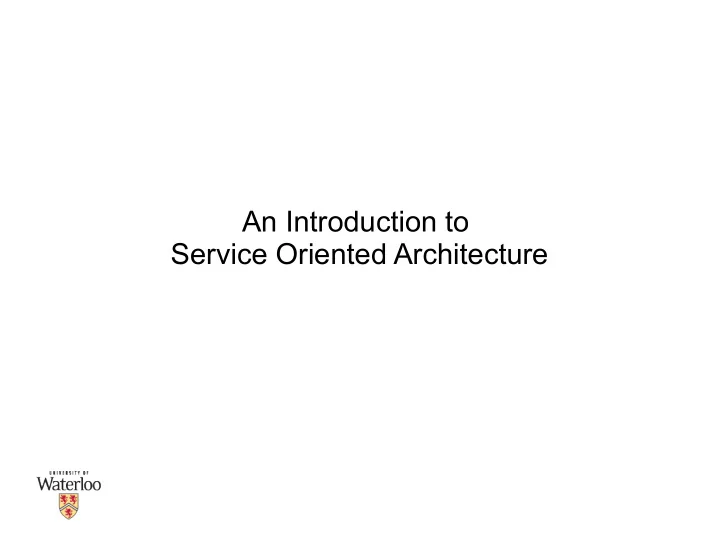

An Introduction to Service Oriented Architecture
Introduction Definitions – Sommerville ● “Service-oriented architectures (SOAs) are a way of developing distributed systems where system components are stand-alone services, executing on geographically distributed computers” – OASIS (Organization for the Advancement of Structured Information Standards) ● “A paradigm for organizing and utilizing distributed capabilities that may be under the control of different ownership domains. It provides a uniform means to offer, discover, interact with and use capabilities to produce desired effects consistent with measurable preconditions and expectations.” OASIS
Introduction Components ● services – “A loosely-coupled reusable software component that encapsulates discrete functionality, which maybe distributed and programmatically accessed.” SOMMERVILLE Connectors ● messages – meta-data ● service descriptions, service interface etc. ● semantic meta-data
Introduction Functional Apps Enterprise Apps SOA Apps Paul A. Strassmann Professor of Information Sciences Volgenau School of Information Technology and Engineering at George Mason University http://www.strassmann.com/
Characteristics Integration ● “mesh-up” of different services – does a newspaper qualify as an SOA? ● an application – various services linked together – really an ad-hoc application Scope ● narrowly focused ● services are simple and generally perform a single task
Characteristics Dependency ● deployment ● execution ● usage – need to know what a service expects and what it returns Stateful vs. Statelessness ● ask the class??
Characteristics Loose coupling ● service bindings can change whenever – different but equivalent services can execute at different times ● interface definition does not change Reusability ● desirable to have reusable services
Characteristics Independent of ● Platform ● Implementation Discoverable Service Broker ● published Publish Discover ● discovered via discovery mechanisms Service Service Consumer Provider – UDDI – web services service service – simple search service client service
Ian Gorton, Essential Software Architecture
Considerations Performance ● Computational penalties – introduction of extra layers – slower then native/binary RPC – Do we need to use XML based RPC? ● Communication latency Evolution ● how should we handle legacy systems – wrap the legacy system in service wrappers
Considerations Service granularity ● reuse vs. performance Fault-Tolerance ● partial failure vs. complete failure ● idempotent request Service agreement ● availability, cost, ● performance
Considerations Governance ● increases in difficulty – with an increase in diversely deployed services – many service providers ● meta-data management ● trust
SOA Levels of Abstractions http://msdn.microsoft.com/en-us/library/aa480021.aspx#aj1soa_topic5
Three Architectural Perspectives Application Architecture ● business facing solution ● consumes services from one or more providers ● integrates them into the business processes The Service Architecture ● a bridge between the implementations and the consuming applications ● logical view of sets of services which are available for use http://msdn.microsoft.com/en-us/library/aa480021.aspx#aj1soa_topic5
Three Architectural Perspectives The Component Architecture ● various environments supporting – the implemented applications – the business objects and their implementations http://msdn.microsoft.com/en-us/library/aa480021.aspx#aj1soa_topic5
Three Architectural Perspectives http://msdn.microsoft.com/en-us/library/aa480021.aspx#aj1soa_topic5
Considerations Marginal Benefit ● benefits offered to the first application ● benefits offered to the nth application Testing ● lack of tools ● lack of test services environment Security ● authentication (WS-Security, SAML, WS-Trust) ● still very green
Infrastructure Services Fundamental service layer ● data ● security ● computing ● communication ● applications
Another Look SOA ● business-centric IT architectural approach ● consuming a service is usually cheaper then doing the work Example ● DNS – reusable, scalable, fault-tolerant, well defined scope
Another Look Web Services ● would you classify web-services as SOA? ● web services – a technology – middle-ware – an implementation of SOA
From Applications to Services Nan Yang Chief Architect (Client Solutions Greater China Sun Microsystems) ICSE Shanghai 2006
From Applications to Services Nan Yang Chief Architect (Client Solutions Greater China Sun Microsystems) ICSE Shanghai 2006
From Applications to Services Nan Yang Chief Architect (Client Solutions Greater China Sun Microsystems) ICSE Shanghai 2006
From Applications to Services Nan Yang Chief Architect (Client Solutions Greater China Sun Microsystems) ICSE Shanghai 2006
From Applications to Services Nan Yang Chief Architect (Client Solutions Greater China Sun Microsystems) ICSE Shanghai 2006
From Applications to Services Nan Yang Chief Architect (Client Solutions Greater China Sun Microsystems) ICSE Shanghai 2006
From Applications to Services Nan Yang Chief Architect (Client Solutions Greater China Sun Microsystems) ICSE Shanghai 2006
From Applications to Services Nan Yang Chief Architect (Client Solutions Greater China Sun Microsystems) ICSE Shanghai 2006
Recommend
More recommend